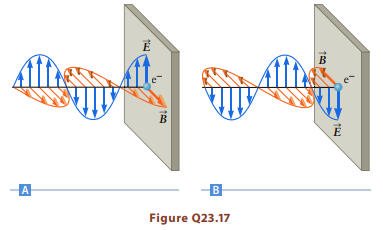In Figure 23.5, we analyzed the force exerted by the electric and magnetic fields of an electromagnetic
Question:
In Figure 23.5, we analyzed the force exerted by the electric and magnetic fields of an electromagnetic wave on an electric charge at the surface of a material when the electric field has the direction shown in Figure Q23.17A. That analysis considered the force on a positive charge at a particular instant in time, with particular directions for the electric and magnetic fields. Since the mobile charges in a metal are negative (i.e., electrons) and the electric and magnetic fields oscillate in direction, it is important to consider this force for negative charges and other field directions.
(a) Assume the charge is instead negative (i.e., an electron). Show that the combination of electric and magnetic fields shown in Figure Q23.17A leads to a force on the electron with a component to the right.
(b) After a short time, the electric field of the wave at the location of the electron changes direction and is pointing down as shown in Figure Q23.17B. Consider again the combined electric and magnetic forces on the electron and show that it again has a component to the right. The conclusion of this analysis is that although the electric and magnetic fields oscillate in direction, there is over time always a component of the force along the direction of propagation (except at instants when the force is zero). This force is connected with the wave’s momentum.

Step by Step Answer:

College Physics Reasoning and Relationships
ISBN: 978-0840058195
2nd edition
Authors: Nicholas Giordano





